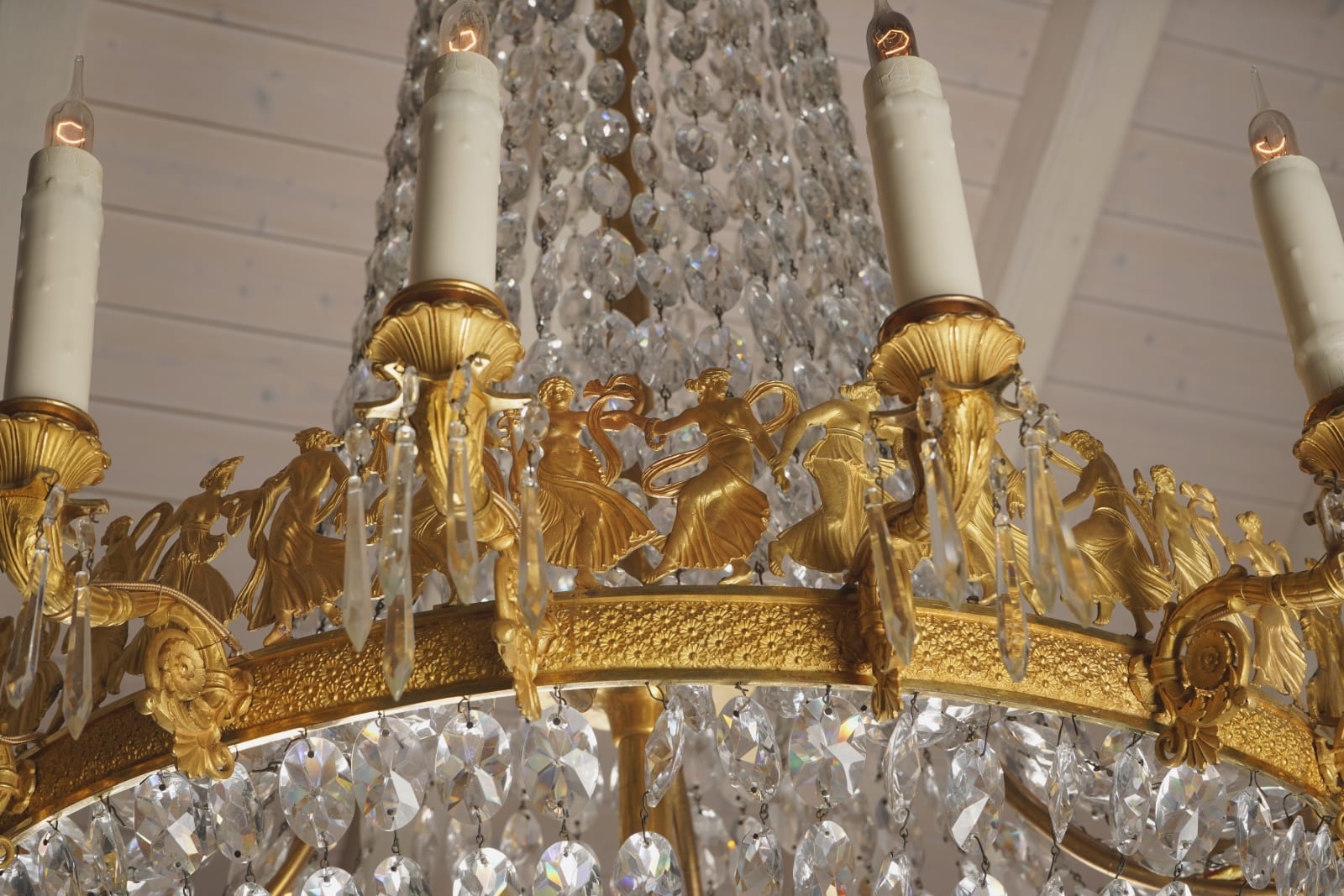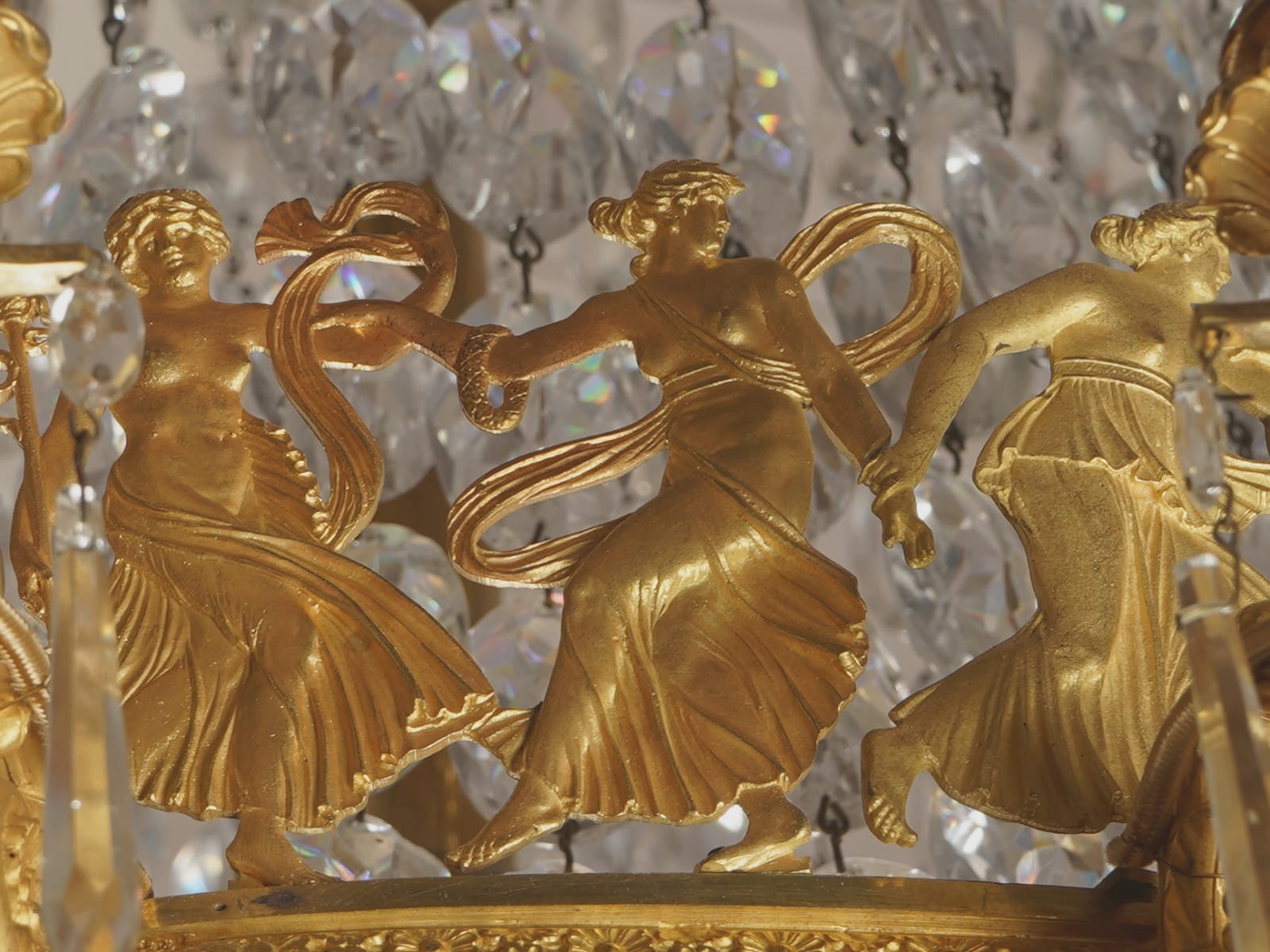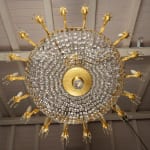Pierre-Philippe Thomire (attributed to) French, 1731-1843
Width: 120cm
Further images
Literature
Hans Ottomeyer and Peter Pröschel, “Vergoldete Bronzen”, 1986, p. 358, pl. 5.11.2, illustrating a watercolour designs for a comparable chandelier by Antoine-André Ravrio of 1810, as part of a project for the Emperor Napoleon, now in the Musée des Arts Décoratifs, Paris. Pierre Arizzoli-Clémantel and Jean-Pierre Samoyault, “Le Mobilier de Versailles: Chefs-d’Oeuvre de XIXe Siècle”, 2009, p. 141 illustrating a magnificent Empire guéridon with circular white marble top above a frieze mounted with almost identical gilt bronze dancing maenads. Marie-France Dupuy-Baylet, “L’Heure, Le Feu, La Lumière: Les Bronzes du Mobilier National 1800-1870”, 2010, p. 37, illustrating a gilt bronze mounted cut-glass sixteen-light chandelier of circa 1805 in the Palais d’Élysée, once in the grande galerie of the prince and princesse Murat and now in the salon des officiers des grands appartements, which features a very similar ring of dancing maenads or bacchantes.
An extremely beautiful and fine quality Empire gilt bronze and cut-glass eighteen-light chandelier attributed to Pierre-Philippe Thomire, the circular corona surmounted by palm-shaped finials suspending swagged cut-glass drops above a cascade of drops to a panelled gilt ring cast with overlapping rosettes upon which is a frieze formed of beautiful dancing semi-dressed maenads holding garlands who seemingly pass one another as they dance in opposing directions, the main ring issuing eighteen foliate scrolled and fluted branches, each with vase-shaped nozzles and circular drip-pans below which are projecting arms from which suspend cut-glass drops, the basket base supported by four ribs terminating in a gilt bronze base cast with lotus leaves and centred by a cut-glass boss.
Paris, date circa 1810
Height to follow.
Although this magnificent eighteenth-light piece bares comparison to a design by the Empire bronzier Antoine-André Ravrio (1759-1814), its quality and style is closer to that of the esteemed fondeur-ciseleur Pierre-Philippe Thomire (1751-1843). Like a number of his contemporaries, Thomire included maenads or bacchantes (female followers of Bacchus, mythological god of wine) within his designs, for instance on the plinth of a figural candelabra in Ludwigsburg Castle (illustrated in Ottomeyer and Pröschel, p. 335, pl. 5.2.17) and again around the frieze of an elaborate plinth supporting his Cupid and Psyche clock, now in the Hermitage Museum, St. Petersburg (illustrated in Ottomeyer and Pröschel, p. 321, pl. 5e).
Generally regarded as the leading fondeur-ciseleur of his day, Thomire enjoyed the patronage of Louis XVI, Napoleon and Louis XVIII as well as foreign monarchy and aristocracy. Born in Paris, he began his training under the sculptors Jean-Antoine Houdon and Augustin Pajou at the Académie Saint-Luc, Paris and then followed his father’s profession as a fondeur-ciseleur. He studied under the great fondeur-doreur, Pierre Gouthière, from whom he acquired the most refined skills in chasing and gilding, in particular matt gilding ‘dorure au matt’, to produce a subtle grainy satin-like finish. Appointed a maître-fondeur in 1772, he set up his own business in 1776 following his collaboration with Jean-Louis Prieur in the decoration of the coronation coach for Louis XVI. His fame was propelled to even greater heights after the Revolution when in 1806 he became the first bronzier to be awarded a gold medal at the Exposition des Produits de l’Industrie. Three years later he won another gold medal and was also appointed ciseleur de l’Empereur. In 1804 Thomire purchased the extensive business of the marchand-mercier, Martin-Eloi Lignereux, which enabled him to operate on a broader basis, as a retailer of furniture and decorative objects as well as maker of bronzes and furniture. Thomire collaborated with three partners, renaming the business Thomire, Duterme & Cie, which rapidly achieved prominence and many Imperial commissions. But Thomire, like other Parisian firms suffered as a result of France’s continuing wars; to avoid bankruptcy the firm was granted a dispensation to trade with the Prince Regent (later George IV of England). Despite their close association with the Imperial House, the firm survived Napoleon’s downfall. Soon after 1815 the partnership with Duterme was dissolved and under its new style, Thomire et Cie flourished once more under the restored Bourbons. Thomire retired in 1823 at which point his two sons-in-law ran the concern and subsequently Thomire’s grandsons up until the firm’s closure in 1852. Thomire continued to work as a sculptor and exhibited regularly at the Salon until 1834.









